Effective Induction Program for Accountants: A Comprehensive Guide
VerifiedAdded on 2020/03/16
|6
|1302
|1368
Report
AI Summary
This report provides a detailed analysis of an accountant induction program, emphasizing its importance for new hires in accounting firms. It covers the benefits of such programs, including increased employee satisfaction, reduced turnover, and improved productivity. The report outlines key components of an effective induction program, such as formal orientation, on-the-job training, structured training modules, and clear communication of policies and procedures. It also highlights the significance of workplace safety and emergency procedures, as well as frequent evaluation meetings to assess employee progress. The report draws on examples from top accounting firms like Maxim, illustrating practical implementation strategies. The references cited provide further context and support for the concepts presented, offering a comprehensive guide to designing and implementing a successful accountant induction program.
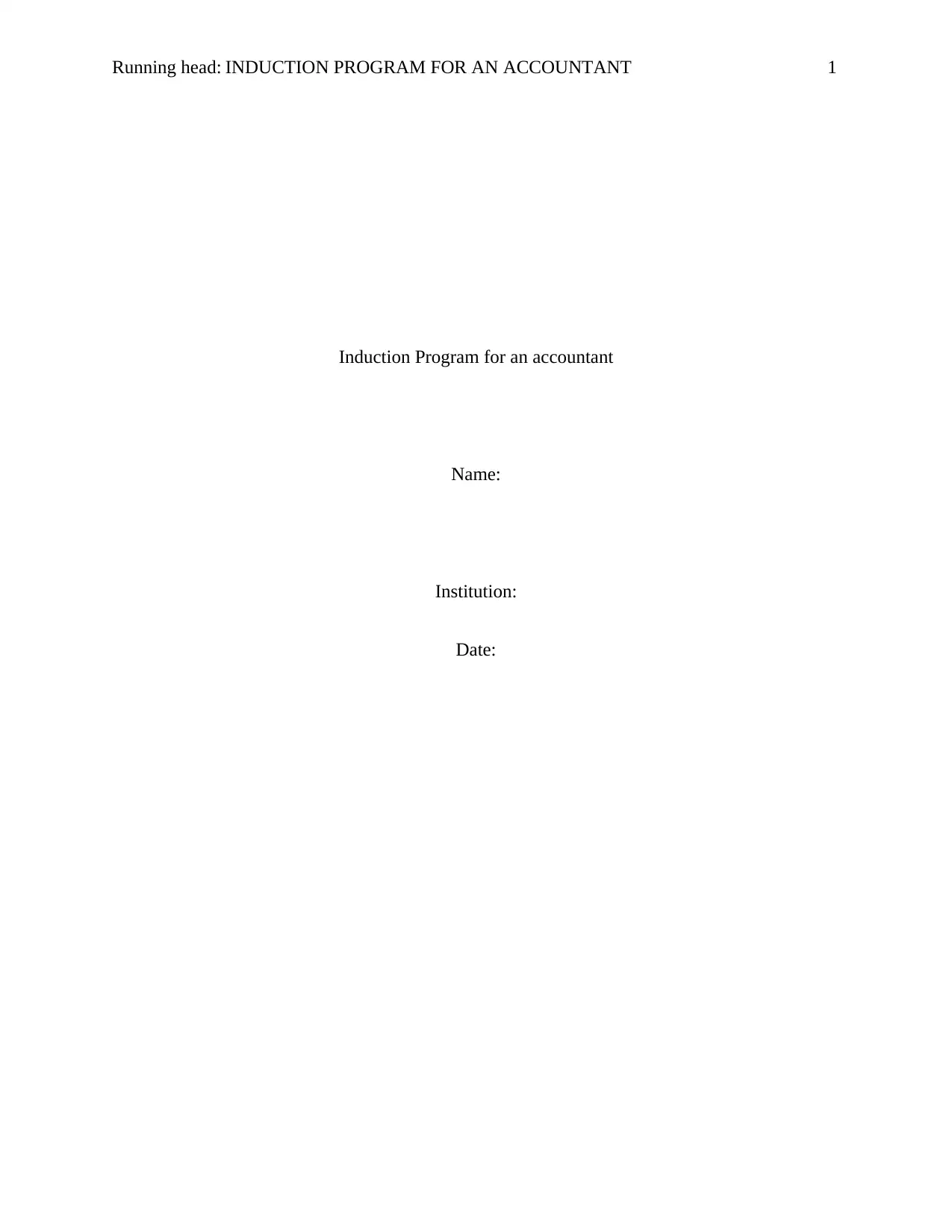
Running head: INDUCTION PROGRAM FOR AN ACCOUNTANT 1
Induction Program for an accountant
Name:
Institution:
Date:
Induction Program for an accountant
Name:
Institution:
Date:
Paraphrase This Document
Need a fresh take? Get an instant paraphrase of this document with our AI Paraphraser
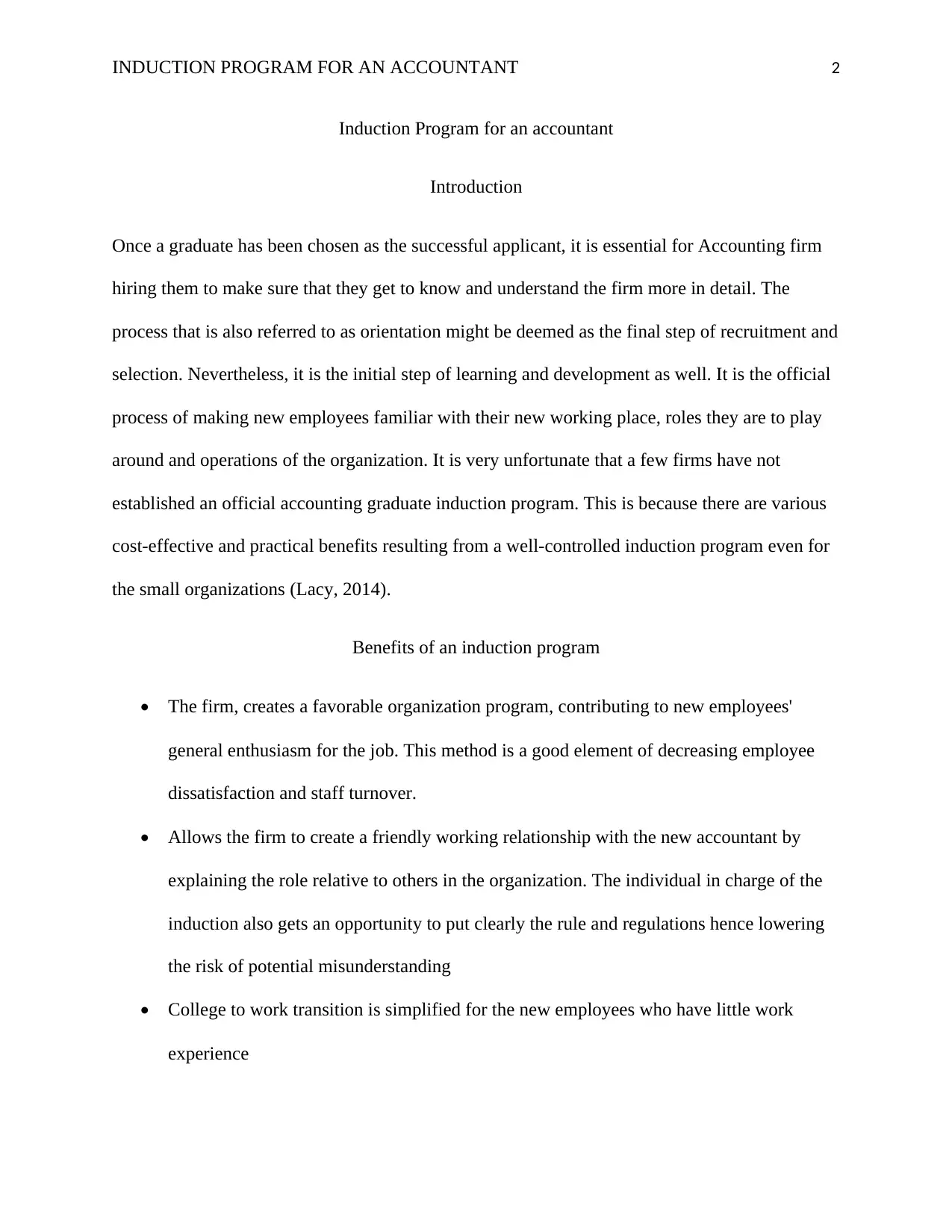
INDUCTION PROGRAM FOR AN ACCOUNTANT 2
Induction Program for an accountant
Introduction
Once a graduate has been chosen as the successful applicant, it is essential for Accounting firm
hiring them to make sure that they get to know and understand the firm more in detail. The
process that is also referred to as orientation might be deemed as the final step of recruitment and
selection. Nevertheless, it is the initial step of learning and development as well. It is the official
process of making new employees familiar with their new working place, roles they are to play
around and operations of the organization. It is very unfortunate that a few firms have not
established an official accounting graduate induction program. This is because there are various
cost-effective and practical benefits resulting from a well-controlled induction program even for
the small organizations (Lacy, 2014).
Benefits of an induction program
• The firm, creates a favorable organization program, contributing to new employees'
general enthusiasm for the job. This method is a good element of decreasing employee
dissatisfaction and staff turnover.
• Allows the firm to create a friendly working relationship with the new accountant by
explaining the role relative to others in the organization. The individual in charge of the
induction also gets an opportunity to put clearly the rule and regulations hence lowering
the risk of potential misunderstanding
• College to work transition is simplified for the new employees who have little work
experience
Induction Program for an accountant
Introduction
Once a graduate has been chosen as the successful applicant, it is essential for Accounting firm
hiring them to make sure that they get to know and understand the firm more in detail. The
process that is also referred to as orientation might be deemed as the final step of recruitment and
selection. Nevertheless, it is the initial step of learning and development as well. It is the official
process of making new employees familiar with their new working place, roles they are to play
around and operations of the organization. It is very unfortunate that a few firms have not
established an official accounting graduate induction program. This is because there are various
cost-effective and practical benefits resulting from a well-controlled induction program even for
the small organizations (Lacy, 2014).
Benefits of an induction program
• The firm, creates a favorable organization program, contributing to new employees'
general enthusiasm for the job. This method is a good element of decreasing employee
dissatisfaction and staff turnover.
• Allows the firm to create a friendly working relationship with the new accountant by
explaining the role relative to others in the organization. The individual in charge of the
induction also gets an opportunity to put clearly the rule and regulations hence lowering
the risk of potential misunderstanding
• College to work transition is simplified for the new employees who have little work
experience
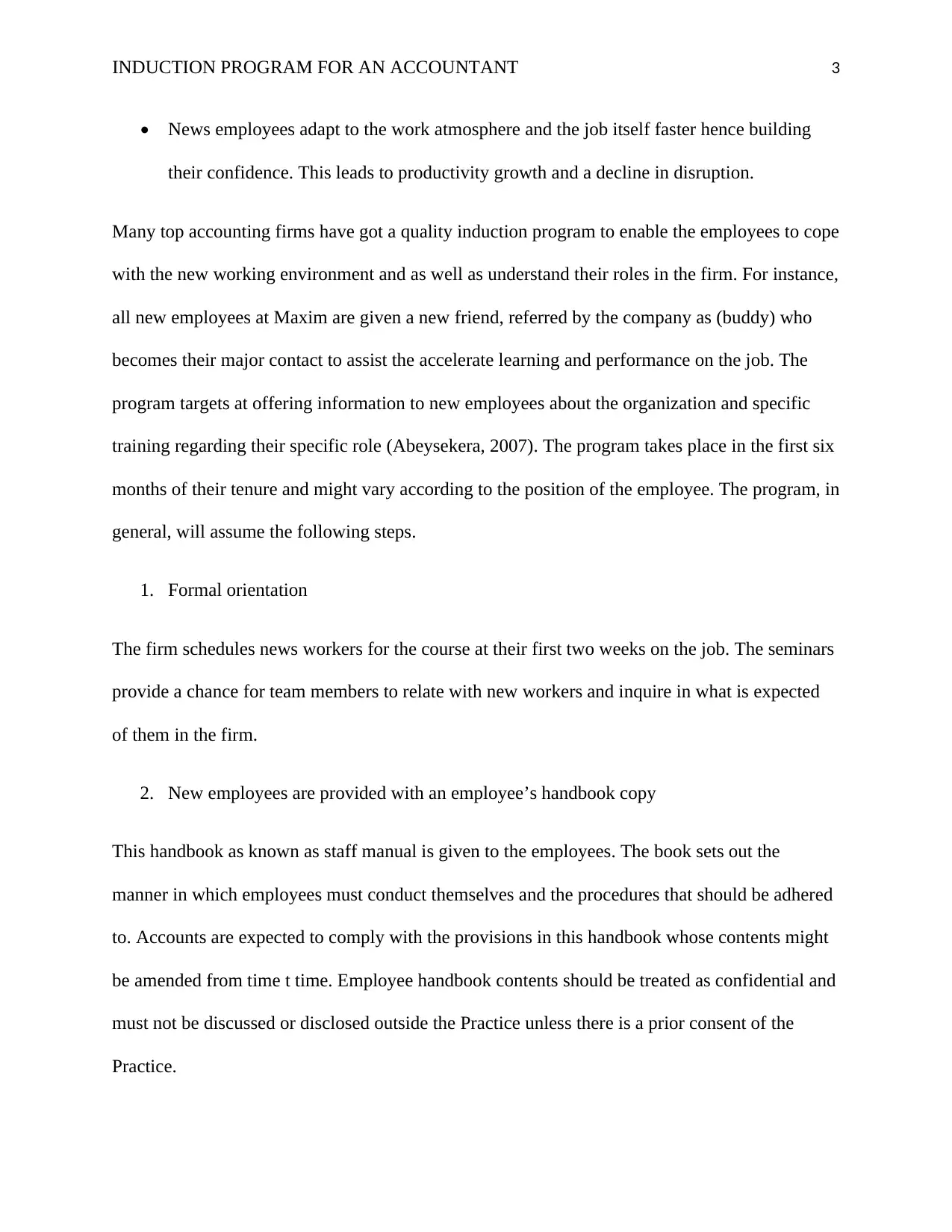
INDUCTION PROGRAM FOR AN ACCOUNTANT 3
• News employees adapt to the work atmosphere and the job itself faster hence building
their confidence. This leads to productivity growth and a decline in disruption.
Many top accounting firms have got a quality induction program to enable the employees to cope
with the new working environment and as well as understand their roles in the firm. For instance,
all new employees at Maxim are given a new friend, referred by the company as (buddy) who
becomes their major contact to assist the accelerate learning and performance on the job. The
program targets at offering information to new employees about the organization and specific
training regarding their specific role (Abeysekera, 2007). The program takes place in the first six
months of their tenure and might vary according to the position of the employee. The program, in
general, will assume the following steps.
1. Formal orientation
The firm schedules news workers for the course at their first two weeks on the job. The seminars
provide a chance for team members to relate with new workers and inquire in what is expected
of them in the firm.
2. New employees are provided with an employee’s handbook copy
This handbook as known as staff manual is given to the employees. The book sets out the
manner in which employees must conduct themselves and the procedures that should be adhered
to. Accounts are expected to comply with the provisions in this handbook whose contents might
be amended from time t time. Employee handbook contents should be treated as confidential and
must not be discussed or disclosed outside the Practice unless there is a prior consent of the
Practice.
• News employees adapt to the work atmosphere and the job itself faster hence building
their confidence. This leads to productivity growth and a decline in disruption.
Many top accounting firms have got a quality induction program to enable the employees to cope
with the new working environment and as well as understand their roles in the firm. For instance,
all new employees at Maxim are given a new friend, referred by the company as (buddy) who
becomes their major contact to assist the accelerate learning and performance on the job. The
program targets at offering information to new employees about the organization and specific
training regarding their specific role (Abeysekera, 2007). The program takes place in the first six
months of their tenure and might vary according to the position of the employee. The program, in
general, will assume the following steps.
1. Formal orientation
The firm schedules news workers for the course at their first two weeks on the job. The seminars
provide a chance for team members to relate with new workers and inquire in what is expected
of them in the firm.
2. New employees are provided with an employee’s handbook copy
This handbook as known as staff manual is given to the employees. The book sets out the
manner in which employees must conduct themselves and the procedures that should be adhered
to. Accounts are expected to comply with the provisions in this handbook whose contents might
be amended from time t time. Employee handbook contents should be treated as confidential and
must not be discussed or disclosed outside the Practice unless there is a prior consent of the
Practice.
⊘ This is a preview!⊘
Do you want full access?
Subscribe today to unlock all pages.

Trusted by 1+ million students worldwide
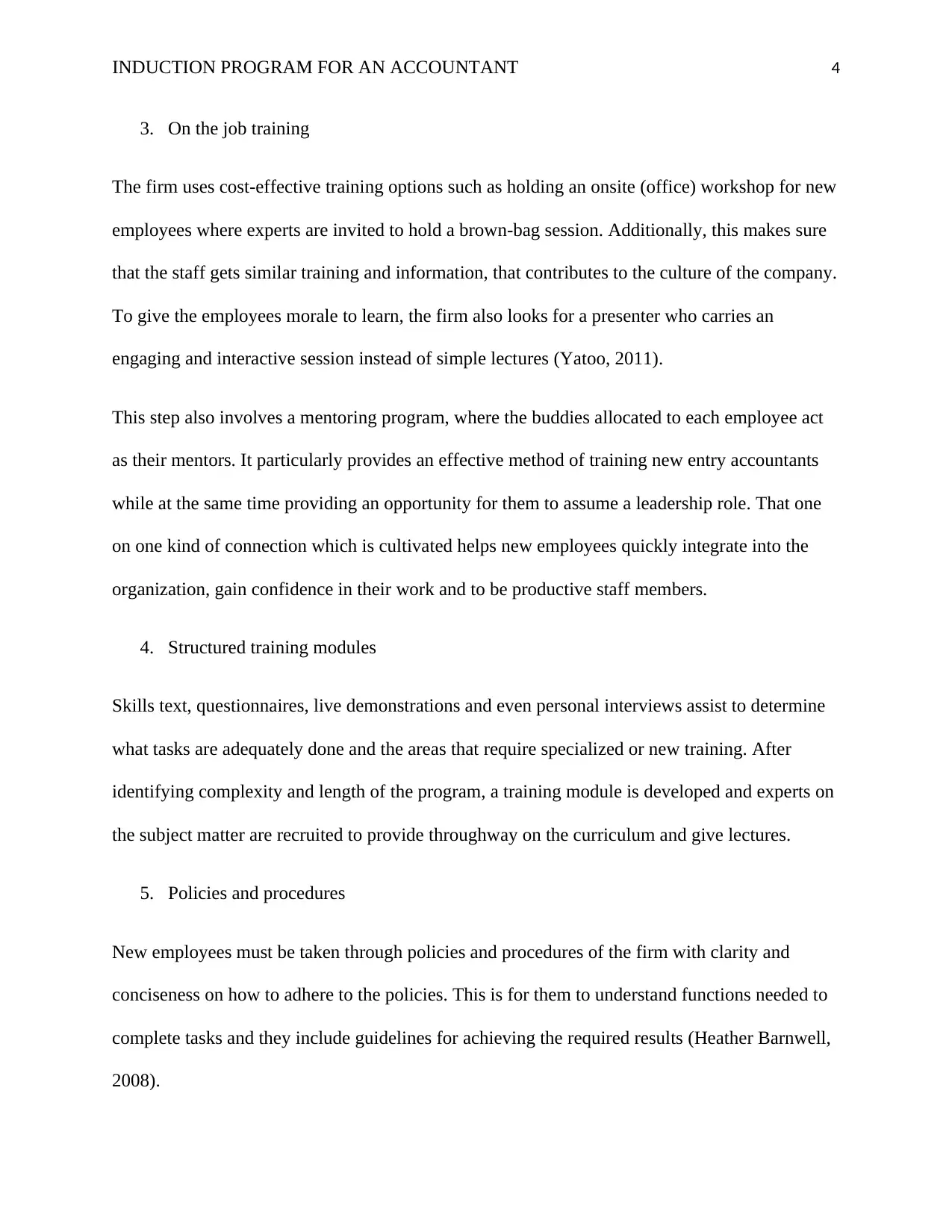
INDUCTION PROGRAM FOR AN ACCOUNTANT 4
3. On the job training
The firm uses cost-effective training options such as holding an onsite (office) workshop for new
employees where experts are invited to hold a brown-bag session. Additionally, this makes sure
that the staff gets similar training and information, that contributes to the culture of the company.
To give the employees morale to learn, the firm also looks for a presenter who carries an
engaging and interactive session instead of simple lectures (Yatoo, 2011).
This step also involves a mentoring program, where the buddies allocated to each employee act
as their mentors. It particularly provides an effective method of training new entry accountants
while at the same time providing an opportunity for them to assume a leadership role. That one
on one kind of connection which is cultivated helps new employees quickly integrate into the
organization, gain confidence in their work and to be productive staff members.
4. Structured training modules
Skills text, questionnaires, live demonstrations and even personal interviews assist to determine
what tasks are adequately done and the areas that require specialized or new training. After
identifying complexity and length of the program, a training module is developed and experts on
the subject matter are recruited to provide throughway on the curriculum and give lectures.
5. Policies and procedures
New employees must be taken through policies and procedures of the firm with clarity and
conciseness on how to adhere to the policies. This is for them to understand functions needed to
complete tasks and they include guidelines for achieving the required results (Heather Barnwell,
2008).
3. On the job training
The firm uses cost-effective training options such as holding an onsite (office) workshop for new
employees where experts are invited to hold a brown-bag session. Additionally, this makes sure
that the staff gets similar training and information, that contributes to the culture of the company.
To give the employees morale to learn, the firm also looks for a presenter who carries an
engaging and interactive session instead of simple lectures (Yatoo, 2011).
This step also involves a mentoring program, where the buddies allocated to each employee act
as their mentors. It particularly provides an effective method of training new entry accountants
while at the same time providing an opportunity for them to assume a leadership role. That one
on one kind of connection which is cultivated helps new employees quickly integrate into the
organization, gain confidence in their work and to be productive staff members.
4. Structured training modules
Skills text, questionnaires, live demonstrations and even personal interviews assist to determine
what tasks are adequately done and the areas that require specialized or new training. After
identifying complexity and length of the program, a training module is developed and experts on
the subject matter are recruited to provide throughway on the curriculum and give lectures.
5. Policies and procedures
New employees must be taken through policies and procedures of the firm with clarity and
conciseness on how to adhere to the policies. This is for them to understand functions needed to
complete tasks and they include guidelines for achieving the required results (Heather Barnwell,
2008).
Paraphrase This Document
Need a fresh take? Get an instant paraphrase of this document with our AI Paraphraser
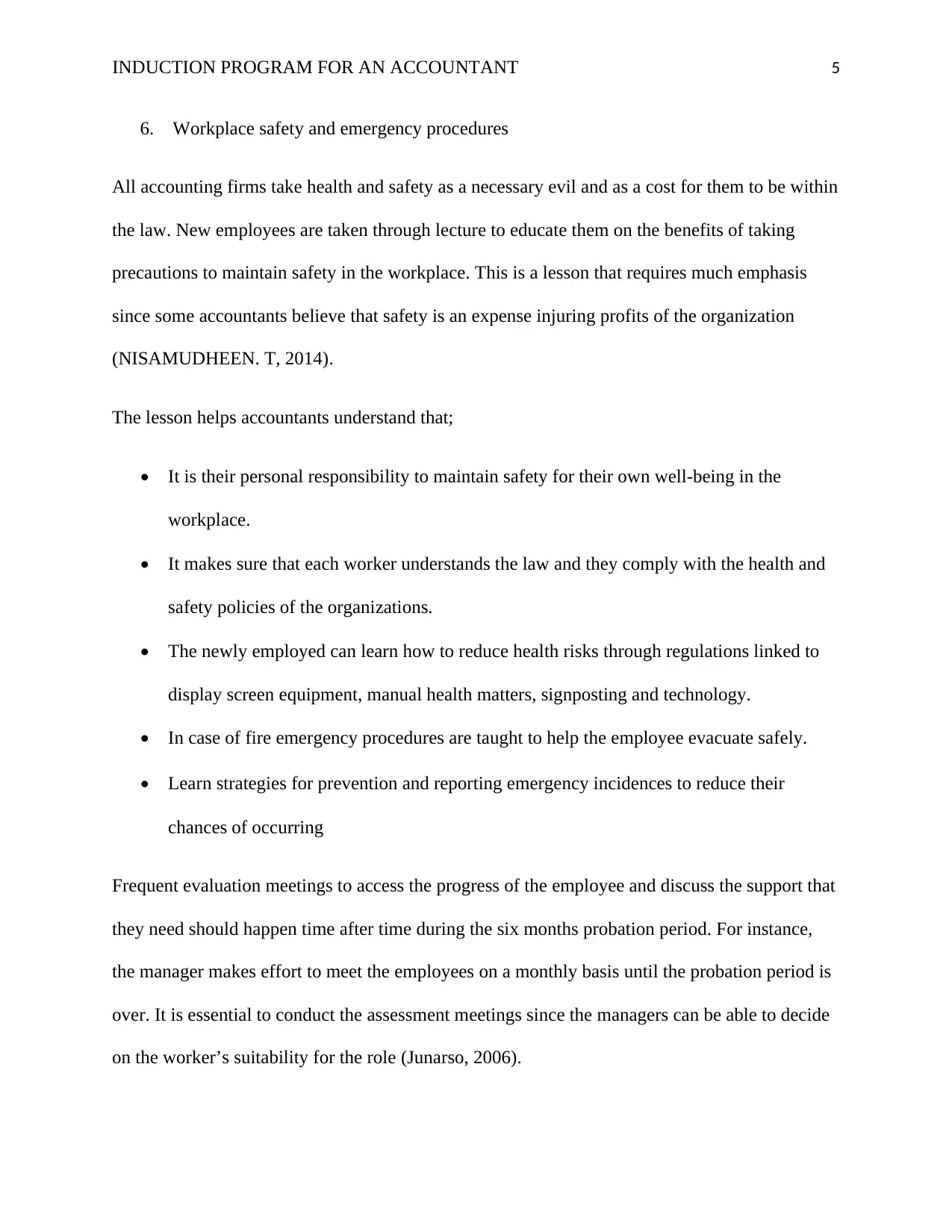
INDUCTION PROGRAM FOR AN ACCOUNTANT 5
6. Workplace safety and emergency procedures
All accounting firms take health and safety as a necessary evil and as a cost for them to be within
the law. New employees are taken through lecture to educate them on the benefits of taking
precautions to maintain safety in the workplace. This is a lesson that requires much emphasis
since some accountants believe that safety is an expense injuring profits of the organization
(NISAMUDHEEN. T, 2014).
The lesson helps accountants understand that;
• It is their personal responsibility to maintain safety for their own well-being in the
workplace.
• It makes sure that each worker understands the law and they comply with the health and
safety policies of the organizations.
• The newly employed can learn how to reduce health risks through regulations linked to
display screen equipment, manual health matters, signposting and technology.
• In case of fire emergency procedures are taught to help the employee evacuate safely.
• Learn strategies for prevention and reporting emergency incidences to reduce their
chances of occurring
Frequent evaluation meetings to access the progress of the employee and discuss the support that
they need should happen time after time during the six months probation period. For instance,
the manager makes effort to meet the employees on a monthly basis until the probation period is
over. It is essential to conduct the assessment meetings since the managers can be able to decide
on the worker’s suitability for the role (Junarso, 2006).
6. Workplace safety and emergency procedures
All accounting firms take health and safety as a necessary evil and as a cost for them to be within
the law. New employees are taken through lecture to educate them on the benefits of taking
precautions to maintain safety in the workplace. This is a lesson that requires much emphasis
since some accountants believe that safety is an expense injuring profits of the organization
(NISAMUDHEEN. T, 2014).
The lesson helps accountants understand that;
• It is their personal responsibility to maintain safety for their own well-being in the
workplace.
• It makes sure that each worker understands the law and they comply with the health and
safety policies of the organizations.
• The newly employed can learn how to reduce health risks through regulations linked to
display screen equipment, manual health matters, signposting and technology.
• In case of fire emergency procedures are taught to help the employee evacuate safely.
• Learn strategies for prevention and reporting emergency incidences to reduce their
chances of occurring
Frequent evaluation meetings to access the progress of the employee and discuss the support that
they need should happen time after time during the six months probation period. For instance,
the manager makes effort to meet the employees on a monthly basis until the probation period is
over. It is essential to conduct the assessment meetings since the managers can be able to decide
on the worker’s suitability for the role (Junarso, 2006).
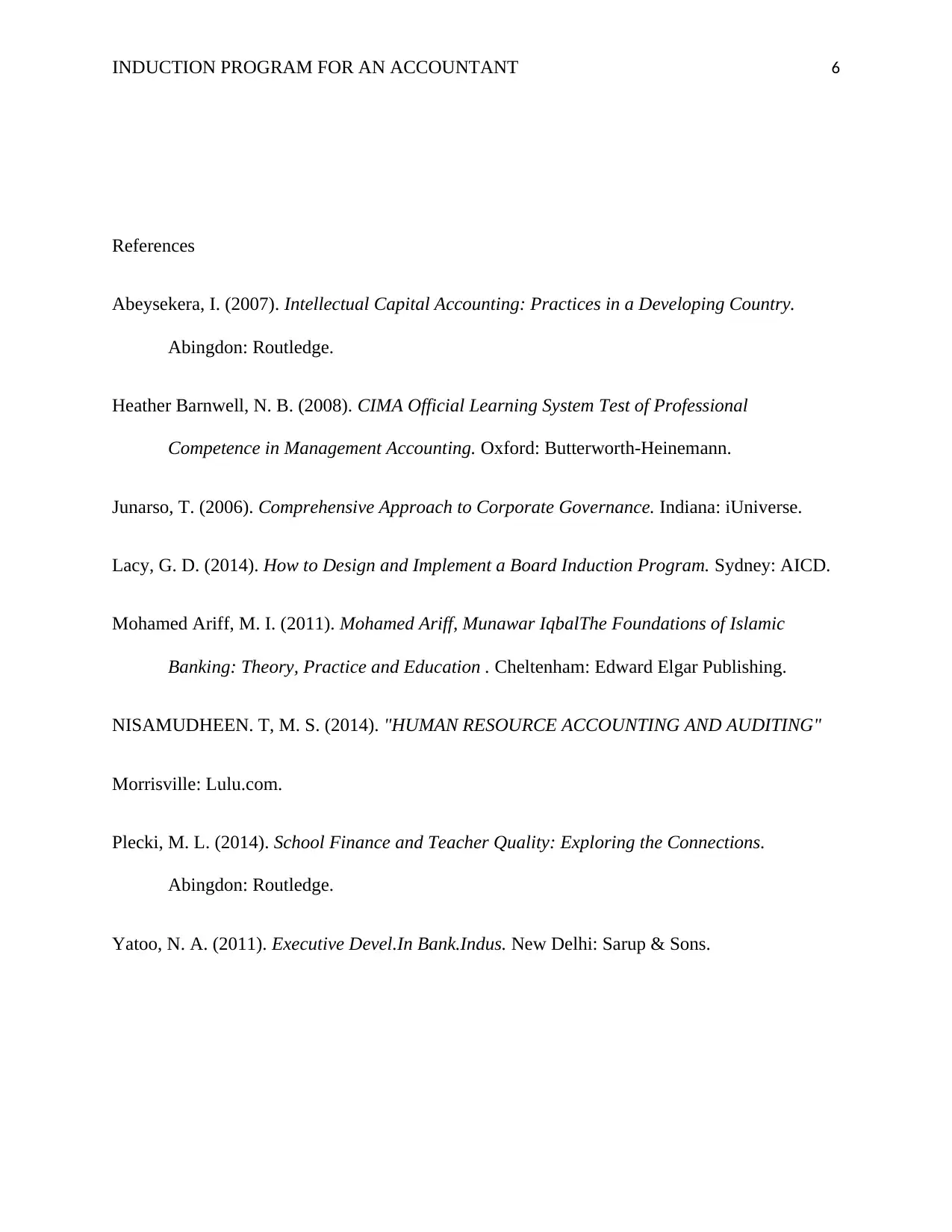
INDUCTION PROGRAM FOR AN ACCOUNTANT 6
References
Abeysekera, I. (2007). Intellectual Capital Accounting: Practices in a Developing Country.
Abingdon: Routledge.
Heather Barnwell, N. B. (2008). CIMA Official Learning System Test of Professional
Competence in Management Accounting. Oxford: Butterworth-Heinemann.
Junarso, T. (2006). Comprehensive Approach to Corporate Governance. Indiana: iUniverse.
Lacy, G. D. (2014). How to Design and Implement a Board Induction Program. Sydney: AICD.
Mohamed Ariff, M. I. (2011). Mohamed Ariff, Munawar IqbalThe Foundations of Islamic
Banking: Theory, Practice and Education . Cheltenham: Edward Elgar Publishing.
NISAMUDHEEN. T, M. S. (2014). "HUMAN RESOURCE ACCOUNTING AND AUDITING"
Morrisville: Lulu.com.
Plecki, M. L. (2014). School Finance and Teacher Quality: Exploring the Connections.
Abingdon: Routledge.
Yatoo, N. A. (2011). Executive Devel.In Bank.Indus. New Delhi: Sarup & Sons.
References
Abeysekera, I. (2007). Intellectual Capital Accounting: Practices in a Developing Country.
Abingdon: Routledge.
Heather Barnwell, N. B. (2008). CIMA Official Learning System Test of Professional
Competence in Management Accounting. Oxford: Butterworth-Heinemann.
Junarso, T. (2006). Comprehensive Approach to Corporate Governance. Indiana: iUniverse.
Lacy, G. D. (2014). How to Design and Implement a Board Induction Program. Sydney: AICD.
Mohamed Ariff, M. I. (2011). Mohamed Ariff, Munawar IqbalThe Foundations of Islamic
Banking: Theory, Practice and Education . Cheltenham: Edward Elgar Publishing.
NISAMUDHEEN. T, M. S. (2014). "HUMAN RESOURCE ACCOUNTING AND AUDITING"
Morrisville: Lulu.com.
Plecki, M. L. (2014). School Finance and Teacher Quality: Exploring the Connections.
Abingdon: Routledge.
Yatoo, N. A. (2011). Executive Devel.In Bank.Indus. New Delhi: Sarup & Sons.
⊘ This is a preview!⊘
Do you want full access?
Subscribe today to unlock all pages.

Trusted by 1+ million students worldwide
1 out of 6
Related Documents
Your All-in-One AI-Powered Toolkit for Academic Success.
+13062052269
info@desklib.com
Available 24*7 on WhatsApp / Email
![[object Object]](/_next/static/media/star-bottom.7253800d.svg)
Unlock your academic potential
Copyright © 2020–2025 A2Z Services. All Rights Reserved. Developed and managed by ZUCOL.




